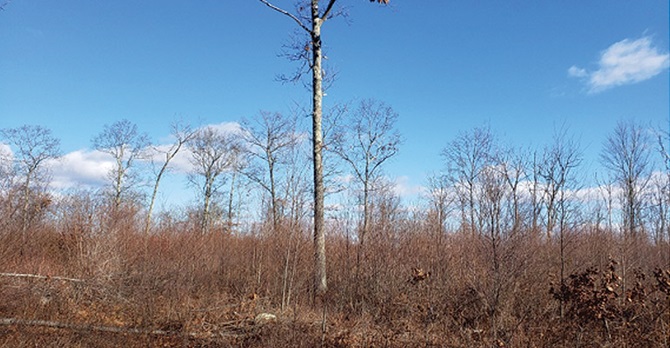Irregular Shelterwood Harvest
Irregular Shelterwood Harvest: Immediately After

Figure 9: The overstory was mostly removed to regenerate the area to a new forest age class. All understory vegetation was cut to let sunlight reach the forest floor. The increased sunlight will stimulate vegetative growth from stored seed in the soil and sprouting from cut stumps. The photo shows cut trees waiting to be pulled from the woods and sent to a sawmill to be made into sustainable forest products.
Forester's View
This stand was prescribed an irregular shelterwood harvest as part of a 2012 Forest Resource Management Plan. The management goal is to grow a new age class of shade intolerant oak forest, and increase underrepresented, early successional habitat in the State Forest. After the harvest, portions of the stand received nearly full sun, while other areas retained low densities of trees for seed dispersal, forest structure, and wildlife related benefits. The logger implemented the harvest plan very conscientiously, with minimal damage to the residual trees, and excellent site scarification, which will benefit seed germination and reproduction.
Irregular Shelterwood Harvest: After

Figure 10: The treated area seven years after the harvest. The area has regenerated back to dense trees and shrubs providing a new forest age class. The harvest has enhanced habitat diversity and food sources for a variety of wildlife species.
Forester's View
Seven years after the harvest, the understory has regenerated with thickets of sapling sized trees and a diversity of berry producing shrubs. Portions of the site are so dense it’s difficult to walk through. This condition provides excellent escape cover for small mammals, and important foraging habitat for both young forest dependent, and forest interior, songbirds. Forest composition is diverse, with ample reproduction from oak, hickory, and birch species throughout the area. This vigorously growing stand will be rapidly sequestering carbon dioxide, providing critical young forest habitat, and benefiting landscape-level forest resilience with its improved ability to bounce back after natural disturbance.
Forest Management on State Lands
Clearcut Treatment
Oak Shelterwood Establishment Harvest
White Pine Thinning
White Pine Plantation Thinning
Irregular Shelterwood Harvest
Content last updated December 2020.

